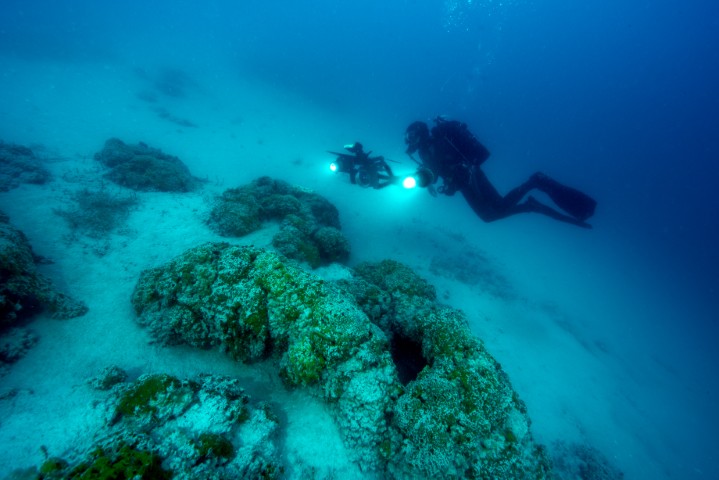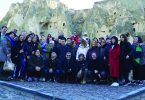We interviewed underwater photographer Ali Ethem Keskin on the riches he discovered during the dives he has made in lakes, sink-holes, fresh water sources and mysterious caves all around Anatolia for the last quarter century.
Interview: MELİH USLU Photography: ALİ ETHEM KESKİN
Could you tell us a bit about yourself? How did your passion for the underwater begin?
I was born in Bursa in 1957. I started taking an interest in underwater at the age of seven after watching The Silent World by Captan Cousteau. The passion for photography followed. I started taking underwater photographs in 1990 and regularly went to scuba-diving. 25 years passed like the wind in the Red Sea, Caribbean, Florida, Borneo, Australia, South China Sea. I look back and realise that I have made more than three thousand dives. Back then, I took a liking in diving in open sea and oceans rich in underwater vegetation. Lately I have steered for inner seas, lakes and fresh water sources. I make documentary shows, and write for travel and geography magazines. I collaborate with various underwater research foundation and organisations.
You have been diving around Anatolia in recent years and are known for these dives. Why have you turned towards Turkey?
The interest I took in Anatolia’s underwater reserves peaked in fall 2000. The reason was the photographs and images I came across which depicted Turkey’s underwater riches in various locations. For instance, when I saw the photographs taken in Yerköprü Waterfall in Hadim district of Konya, I was utterly impressed by blue-green hues and silky texture of the water. Thinking there are countless other fascinating destinations, I decided to discover Turkey’s underwater life. I went to scuba-diving for photography and research purposes on a regular basis between 2001-2015 in seas, lakes, sink-holes, caves, underwater formations and uncharted tunnels and galleries all around Turkey. I still continue to scuba-dive. Naturally, I have acquired an extensive archive in time.
You have dived in almost all major diving spots around the world to date. How is Turkey for diving?
Our country is a true heaven for diving enthusiasts and underwater photographers. The riches we possess over ground have always been the topic till now. However there are countless underwater spots worth seeing and discovering. It is not coincidental that every year thousands of foreign tourists, students visit Turkey to dive. Did you know that the oldest shipwreck was discovered in Turkey? This monument we named Uluburun Shipwreck is exhibited at Bodrum Underwater Archaeology Museum. Kaş, Bodrum, Saroz and Ayvalık Gökçeada are the rising stars of scuba-diving in recent years. There are many diving schools at Kaş. You might make shallow dives after a few days of training. The underwater is pristine and visibility range is high in Saroz. The first underwater national park in Turkey is in Gökçeada. I would also like to add Datça to this list. The coasts are abound with amphora attached to rocks in Datça Peninsula. Particularly the area around Apostol Lighthouse is popular among divers. There are mainly two types of dives organised in Datça: daily diving trips with diving clubs in the area or weekly diving trips with blue cruises. I would recommend.
You mentioned Yerköprü Waterfall. What else fascinated you? Could you give us some details?
Yerköprü Waterfall at 23 kilometres to Hadim district has a one of a kind geological formation. Göksu River that has pumped life to the region throughout the history, enters a cave in Yerköprü and disappears underground. On the other side, Karasu Creek springs as a second river and it resembles a two-tier highway flowing nearly 25 metres above Göksu. Karasu flows above ground for about 500 metres and creates Yerköprü Waterfall, this time flowing over Göksu. And there is more. Karasu Creek’s water with a lime content, covers the rocks around in white just like Pamukkale travertines and offers a unique panorama.
Where exactly did you dive in Yerköprü Waterfall?
Both in springs and in caves behind the waterfall… I remember the caves behind waterfalls in cartoons I used to read. The fictitious characters of our childhood would hide in these caves. This image came true for me in Yerköprü. I was so excited when I crossed to the back of the waterfall. The strong sound of water flowing down from heights creating strong vibrations, gave me chills like in a fantastic performance. At one point in the cave, Göksü River flows underground for a 50 metres long tunnel. And I was a part of the first team that ever went through that tunnel.
You explain the underwater riches you have discovered all around Anatolia both on TV shows and in your seminars. Could you tell us about natural beauties you have encountered?
Of course. I would like to talk about floating islands in Eğirdir Lake. Because in Eğirdir, that is the fourth biggest lake in Turkey, I witnessed a unique natural event. The fallen leaves of the plant named ‘chara’ growing on lake floor accumulated on water surface. These leaves combined with seeds and soil with wind’s effect, formed floating isles that reach a thickness of several metres in time. I might be the first Turkish diver to dive here. It was very interesting. I felt as if diving in a cave. First I dove all the way to the bottom of floating isles. When I looked up towards the sky, the eye-catching details of the lake became more apparent. Green vibrations of lilies accompanied a thousand and one shades of blue. I can say that I had never felt that inspired in a dive before. I also cannot forget the adventurous ice diving trip to Kaçkar Mountains… Big Sea Lake, covered with ice for most part of the year, is at an altitude of 3400 metres. We decided to dive here towards summer, before ice on the lake completely melted. We went to Eastern Black Sea around that time. Frankly, the ice plate covering lake’s surface with a thickness around four metres worried us. We built up our courage and commenced the dive. As I was submerging under the ice, there were questions in my mind like “when will I start feeling cold?”, “will our regulators freeze?”. However as I went deeper, I saw amazing light beams and spectacular underwater formations. One of the most gripping things I had ever experienced.
And which diving spot in Anatolia impressed you the most?
As a matter of fact, I cannot name a single spot. There are many destinations around Turkey ideal for diving. But in my opinion, for instance Azmak Creek in Muğla Akyaka has a special place. The characteristic of this spot is it being a river comprised of numerous proximate water sources lined up for hundreds of metres. This is why it has a crystal clear water. The underwater plants on the bottom dance as if waltzing due to rapid current. Coves carved by the current at the bottom creates amazing underwater views. Another favourite destination is the river at Yazılı Canyon near Çandır village in Isparta. I was short of breath when I first entered the freezing cold water. When I closely inspected the flowing water, I could not believe my eyes. I saw the light refracting under water and breaking into colours. This was an underwater rainbow. I was so thrilled that I could not move for a few seconds. It was extraordinary to photograph that moment.









Leave a Comment